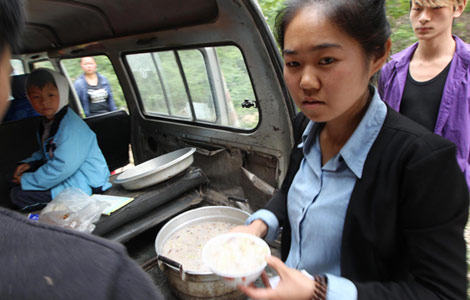Poultry wet market likely source of H7N9 virus
Updated: 2013-04-27 00:33
(Xinhua)
|
||||||||
HONG KONG - Chinese scientists have made a breakthrough in understanding the human infections with avian influenza A H7N9 virus by finding out that poultry wet market might be the source of the deadly virus, according to a research published online on Thursday by the leading international medical journal The Lancet.
The research was conducted by a collaborative research team from The University of Hong Kong and Zhejiang University. They analyze four infected patients in southeast China's Zhejiang Province, and discover for the first time that the patient's virus is genetically very closely related (>/=99.4 percent) to the chicken virus isolated from the epidemiologically linked poultry market. The Lancet publishes the research entitled "Human infections with the emerging avian influenza A H7N9 virus from wet market poultry: clinical analysis and characterization of viral genome" in a timely manner, according to a statement from The University of Hong Kong.
The research analyses four epidemiologically unlinked Zhejiang patients suffering from severe acute community acquired pneumonia not responding to typical and atypical antimicrobial coverage who are found to have the H7N9 virus.
The team shows for the first time that the patient's virus is genetically very closely related (>/=99.4 percent) to the chicken virus isolated from the epidemiologically linked poultry market. Indeed about 20 percent of the chickens in the epidemiologically linked markets were infected with this virus. The researchers thereby believe that poultry wet market might be the source of virus of avian influenza A H7N9 human infection.
Moreover, the team conducts a characterization of viral genome. They find that the patient virus has a PB2 Asp701Asn mutation which is important for adaptation to mammalian host. There are also important mutations on the haemagglutinin, a virus surface protein, facilitating the virus attaching to mammalian host cell. These include the HA Gly186Val and Gln226Leu.
But no person-to-person transmission was found in 303 household or workplace contacts and 82 health-care workers with unprotected exposure to the four patients, according to the research.
Among these four patients, two of them died with respiratory failure, multiorgan dysfunction and markedly elevated serum cytokines and chemokines when compared with the survivors. Research found fatal but not the mild cases exhibit aberrant proinflammatory response of "cytokine storms," which resembles that observed in H5N1 or SARS patients. Another important finding is that virus testing appeared to be more sensitive with lower respiratory tract specimens such as sputum than throat swabs.
All in all, further studies on the virus evolution and disease pathogenesis will be performed to improve disease management and epidemic control, said the statement.
The research team is led by Professor Li Lanjuan of Zhejiang University and Professor Yuen Kwok-yung, the Co-director of the State Key Laboratory of Emerging Infectious Diseases, Department of Microbiology of The University of Hong Kong Li Ka Shing Faculty of Medicine. The deadly H7N9 virus has caused a total of 108 human infections on the Chinese mainland, including 23 cases that have ended in death, the National Health and Family Planning Commission said on Wednesday.
Most Viewed
Editor's Picks

|

|

|

|

|

|
Today's Top News
Phone bookings for taxis in Beijing
Chinese consumers push US exports higher
Seoul delivers ultimatum to DPRK
Boston bombing suspects intended to attack NYC
No let up in home price rises
Bird-watchers undaunted by H7N9 virus
Onset of flood season adds to quake zone risks
Huawei 'not exiting US market'
US Weekly

|

|














